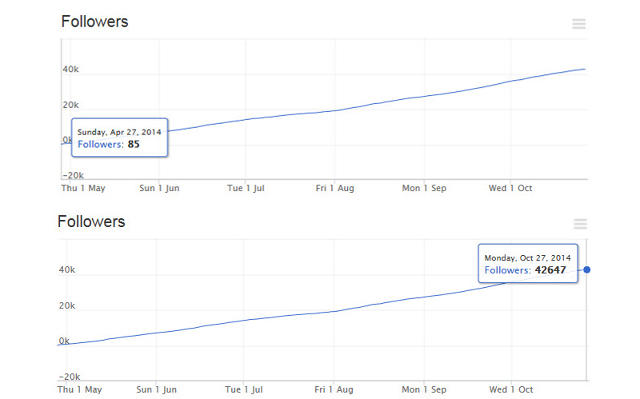I opened my Twitter account a few years ago, but for a while I didn’t have much to show for it. As of April 27, 2014, I had never posted a single tweet and had a mere 85 followers.
From a professional standpoint, that was a problem. I’m the head of a sales training and consulting firm that specializes in applying behavioral science—the study of how the human brain makes choices—to business and sales. I knew I needed to communicate better with more prospective clients, and I wondered what would happen if I applied my science background to boosting my social media reach.
So I decided to set myself up as a guinea pig. But from the outset, I made one rule: I’d never spend more than 15 minutes a day on Twitter. Instead, I’d have to use some behavioral science–backed strategies to produce the greatest results in the shortest amount of time.
What happened next amazed me. In just six months, I had over 42,000 followers, which continued to grow to more than 101,000 followers over the next year and a half. What’s more, my interactions on Twitter also led to consulting engagements and media interviews and even helped me secure a great book deal.

As I began posting on Twitter, I used principles from what behavioral scientists refer to as “choice architecture.” This concept basically says that people make choices contextually—never in a vacuum or strictly in the abstract. So by modifying the way a choice is presented, you can increase the likelihood that it’ll be embraced. Here’s how I put that principle into action.
Tweet What Others Find Valuable
The goal, of course, was to create productive interactions with people I wanted to connect with—pretty much the same objective of anybody who turns to Twitter to build their personal brands or professional networks. But in my case, I wanted to make use of these two powerful triggers of human behavior:
- Reciprocity. It’s just what it sounds like—the social norm that affirms that you should repay others for what they’ve done for you.
- Social exchange theory. Ingrained within human relationships is a desire to maximize benefits and minimize costs. When these costs begin to exceed the benefits, the relationship will be cut off or minimized.
Both of these sound simple enough, right? The challenge was to make sure each interaction on Twitter followed both rules simultaneously—which was trickier than you might think. Twitter encourages impulsive, reactive content—tweets you just toss out quickly when something occurs to you. If you’re only letting yourself book 15 minutes a day, that type of tweeting is a real waste of time.
Instead, I needed to focus on offering something genuinely valuable to the type of user who’d be valuable to have in my network or associated with my brand. So for me, this meant sharing sales and business tips, quotes, articles, and research studies—and avoiding anything else. This may seem to conflict with advice that’s out there about being a sincere, well-rounded user with a range of interests and a clear personality.
But you don’t need to turn into an automaton simply by not tweeting pictures of your dinner plate or live reactions to the Emmys. You can still be you—just the “you” that’s passionate about the things that actually matter to your professional life and, more important still, to the other people you want to help boost it.
I found that this simple strategy improved the likelihood that those who saw what I tweeted as useful would reciprocate by interacting with me. And it kept anybody else, who didn’t, at bay.
Choose, Then Nudge
Tweeting things that others value and not just what interests you is a smart move but will only take you so far. You’ll also need to create a context that motivates others to connect with you. Here’s how I did that.
I decided early on that I didn’t just want passive followers; I wanted a lot of high-quality connections who could impact my business in a meaningful way. So rather than wait and see who would find me, I decided to choose those who I wanted to interact with and then nudge them in my direction. Again, intuitive enough, but not all that easy to do under daily time constraints. So I used this three-step process:
- Identify. Pinpoint business leaders who were similar to me.
- Analyze. Look at their most recently added followers to identify those I’d like to learn more about and interact with. This gave me a pool of potential new followers who I knew, first and foremost, were currently active on Twitter. What’s more, it made their decision to follow me an easy one, because they’d clearly just shown an interest an account similar to my own. In other words, there was a proof of a pattern that they’d already established and recently acted on.
- Connect. Go ahead and reach out to those who’d fulfilled the criteria of step 2.
If both of these ideas sound pretty basic—share content others value, and recruit new followers from recent followers of similar users’ accounts—it’s because they are. But very few of us know to use these tactics consistently or together, or appreciate the deep-seated psychological reasons why they’re so effective.
The success of this approach surprised even me. But I found that many of the people I engaged with would engage right back (replying, favoriting, or retweeting) and, in most cases, ultimately decide to follow me. Strategically sharing content while choosing and nudging potential followers worked in harmony. Anytime you can use the basic science behind how people make choices, it’s likely to pay off—even with minimal effort on your part.
Fast Company , Read Full Story
(17)